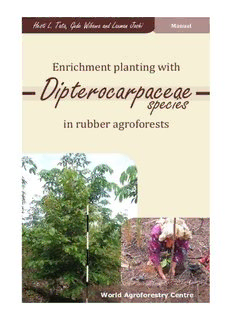
Dipterocarpaceae species - World Agroforestry Centre PDF
Preview Dipterocarpaceae species - World Agroforestry Centre
Hesti L. Tata, Gede Wibawa and Laxman Joshi Manual Enrichment planting with Dipterocarpaceae species in rubber agroforests World Agroforestry Centre Manual Enrichment planting with Dipterocarpaceae species in rubber agroforests Hesti L. Tata,Gede Wibawa and Laxman Joshi Citation Tata HL, Wibawa G, Joshi L. 2008. Enrichment planting with Dipterocarpaceae species in rubber agroforests: manual. Bogor, Indonesia: World Agroforestry Centre (ICRAF) Southeast Asia Regional Program; Indonesian Research Institute for Estate Crops. ISBN 979-3198-49-1 Copyright Copy right, but do not copy wrong. This manual was developed from publicly funded research by the World Agroforestry Centre (ICRAF) Southeast Asia Program and may be used for non-commercial purposes in the interests of the smallholder agroforesters of the world, with acknowledgement to the Centre. Contact Hesti L Tata ([email protected]), Gede Wibawa ([email protected]) and Laxman Joshi ([email protected]) World Agroforestry Centre ICRAF Southeast Asia Regional Office Jl. CIFOR, Situ gede, Sindang Barang PO Box 161, Bogor 16001, Indonesia Tel: +62 251 8625415 Fax: +62 251 8625416 www.worldagroforestrycentre.org/sea Design & Layout Josef C.R Arinto Template design Tikah Atikah Editing Robert Finlayson 2010 Preface Cultivation techniques for meranti (Shorea spp.; Dipterocarpaceae) are already known to foresters through forest rehabilitation and plantation development projects. However, because forest areas are decreasing, planting meranti on non-forest land is becoming increasingly important. One of the potential areas for meranti development is rubber-tree gardens. Rubber gardens managed as part of an agroforest system are known as rubber agroforests. These gardens have become an attractive alternative site for meranti planting because the meranti can enrich and develop smallholder timber production. Meranti can be planted either with young rubber on open land or with mature trees, although it has different physiological characteristics from rubber. Farmers can plant meranti in their rubber garden, generating benefits both from the rubber's latex and the meranti's timber. This manual was written to promote enrichment planting with meranti in rubber agroforests (Chapter 1); give an introduction to several species of Dipterocarpaceae, their seed physiology and habitat distribution (Chapter 2); nursery techniques for seedlings and cuttings (Chapter 3); and cultivation techniques, including land preparation, planting distance and seed maintenance (Chapter 4). This manual was compiled based on results of research we conducted in Bungo and Tebo districts, Jambi province, Sumatra, Indonesia. It is intended to be used as a field handbook for practitioners, extension workers, farmers and anyone else who wants to plant meranti or other Dipterocarpaceae species in rubber gardens. Using this manual, rubber farmers can develop their own nursery independently or together in farmers' groups, by collecting seeds from forests or other sites. The first author would like to thank the Netherlands Fellowship Program and the Common Fund for Commodities that funded the research. Our deep gratitude goes to colleagues at the World Agroforestry Centre's Muara Bungo office who helped the research activity, Ratna Akiefnawati and Yatni. We would also like to express the same to our colleagues at the Centre's national office in Bogor: Subekti Rahayu who edited the Indonesian text and Robert Finlayson who edited this English version; Tikah Atikah, Josef Arinto and Diah Wulandari for text layout and design. Our strongest appreciation must, however, go to the farmers who participated in the research activities: Abror, Cholic, Jamhuri, Sudiharjo, Sudirman, Sunardi, Supriyadi, Paijan and Rebiman. We hope that this technical manual will be useful to you. Bogor, December 2010 i Contents 1. Introduction 1 2. Morphology and distribution of meranti 3 2.1. Species distribution 3 2.2. Morphology 3 2.3. Growth 4 2.4. Seed physiology 4 3. Meranti nurseries 7 3.1. Nursery development 7 3.2. Nursery preparations 7 3.3. Nursery process 8 3.4. Potting seedlings 9 3.5. Seedlings maintenance 11 3.6. Vegetative propagation 14 4. Planting of meranti 17 4.1. Land preparation 17 4.2. Planting distance 17 4.3. Planting process 19 4.4. Plant maintenance 19 5. Conclusion 21 References 23 iii 1. Introduction The lowland tropical rainforests in Indonesia are dominated by Dipterocarpaceae species with various local names such as meranti, kruing, kapur, mersawa, merawan, bangkirai and balau. They produce valuable timber, known locally as 'carpenter's wood', suitable for high and light construction. Moreover, several Dipterocarpaceae species were identified as producer of non-timber forest products such as tengkawang (illipe nuts) and damar mata kucing (dammar resin from Shorea javanica). Nowadays, demand for natural forest timber is increasing yearly while the rejuvenation of meranti in natural forests is limited. The demand for round wood in the decade 2000–2010 reached 37.6 million m3 per year, yet production in, for example, 2006 was only 19.2 million m3 (http://www.dephut.go.id/index.php?q=id/node/2643). Presently, natural forests and industrial timber plantations produce meranti timber while small-scale private forests usually produce other timbers, such as teak and mahogany. Rubber agroforest systems already exist in several areas in Indonesia and are growing in area in Sumatra and Kalimantan. Dipterocarpaceae species can be interplanted in existing rubber agroforests. A rubber agroforest is a complex agro-ecosystem based on rubber trees. It is managed extensively with low maintenance. This creates a suitable environment for natural growth of non-rubber species (for example, herbs, lianas and other trees). Farmers deliberately allow these non-rubber species to grow and they maintain them in the garden for special purposes such as fruit production, firewood and timber. Based on the characteristics of rubber agroforests and the shade-tolerant characteristic of meranti, Dipterocarpaceae can be successfully planted in rubber agroforests. Our research results show that meranti seedlings (Shorea selanica and Shorea lamellata) grow well in mature rubber agroforests (more than 10 years-old) and young rubber (1 year-old) without shade trees. There are several kinds of meranti or tengkawang that can be planted in smallholder rubber agroforests: Shorea leprosula, Shorea macrophylla (tengkawang tungkul), Shorea parvifolia, Shorea macroptera, Shorea pinanga (tengkawang), Shorea stenoptera, Shorea javanica (damar mata kucing), Shorea lamellata (damar) and Shorea johorensis. 1
Description: